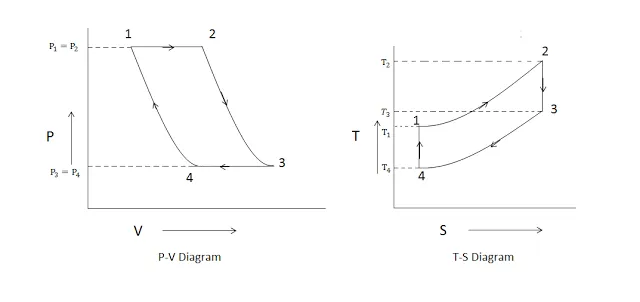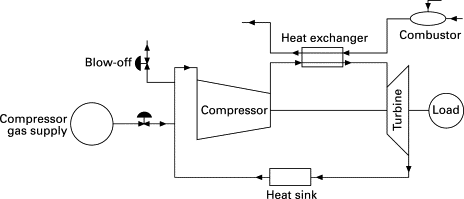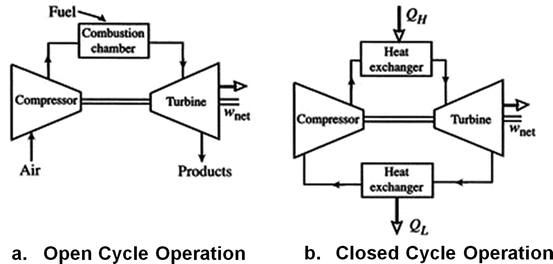In a closed cycle gas turbine, the temperature and pressure of the air entering the compressor are increased. High-pressure and high-temperature compressed air is entered into the heat exchanger, in which an external source heats the air. High temperature and high-pressure air are fed into the turbine to cause expansion.
Due to the high-pressure working fluid that flows over the turbine, closed cycle gas turbines produce power. The exhaust working fluid is not released into the atmosphere but instead cooled by the cooling chamber and recirculated to maintain the system’s continuous operation. As the working fluid is returned to the compressor before the cycle is completed, it is referred to as a closed gas turbine engine.
In order to resolve the disadvantages associated with an open-cycle gas turbine process, a closed cycle gas turbine method is developed. The main drawback of open-cycle turbines is corrosion and erosion of turbine blades. A solution to this problem is to use a superior working medium (air, helium, argon, hydrogen, or neon) that does not mix with the fuel inside the combustion chamber.
A closed cycle method also has the advantage of rejecting heat from exhaust gases via re-coolers, re-heaters, or heat exchangers.
This article provides an overview of the turbine, its working principles, and its advantages and disadvantages.
Basics of Closed Cycle Gas Turbine
Essentially, a closed cycle gas turbine is a thermodynamic system that uses a gas (e.g. air, nitrogen, helium, argon, etc.) as the working fluid. It uses heat that comes from an external source. This Recirculating turbine works on the Brayton cycle. The thermodynamic cycle means that working fluid is used repeatedly without ever leaving the system.
A compressor, a heat chamber, a gas turbine, and a cooling chamber work together to circulate air continuously within this type of turbine. In this type, the ratios of pressure, temperature, and air velocity will be constant.
This diagram shows the simple schematic of a closed cycle gas turbine in detail. The gas turbine drives the generator, compressor, and cooling chamber. The diagram below explains this cycle.

Working Principle of Closed Cycle Gas Turbine
The closed cycle gas turbine works on the basis of the Brayton cycle or Joule’s cycle. Gas is compressed isentropically in this type of gas turbine by a compressor, which then flows into a heating chamber. Rotor-type compressors are preferred in this type of gas turbine. An external heat source is used to heat the compressed air before it is passed over the turbine blades.
As the gas streams over the turbine blades, it expands and enters the cooling chamber, where it is cooled down. Through the circulation of water at constant pressure, the gas is cooled to its initial temperature. Continuing the process, the gas is again passed into the compressor.
This turbine circulates the same gas repeatedly. Using a fluid/medium other than air makes the system more complex and costly. This may cause problems that are hard to fix.
In short, the sequential steps needed to operate a closed cycle gas turbine are:
- The compressor compresses the gas.
- It is then heated up in the heating chamber.
- The gas turbine generates mechanical power.
- The generator then converts the mechanical power into electricity.
- Through the cooling chamber, gas passed from the turbine is cooled.
Thermodynamic Cycle
In the following figure, you can see the P-V and T-S diagrams of a closed cycle gas turbine.

In this turbine, the following processes are used:
Process 1-2
It refers to the heating of gas at constant pressure in a heating chamber. Due to the constant pressure, P1 = P2, and the temperature increasing from temperature T1 to T2 during this process, entropy in the gas increases.
Process 2-3
In this process, the isentropic expansion of gas takes place through turbine blades. Pressure falls from P2 to P3, and volume increases from V2 to V3. Entropy in a T-S diagram stays constant while the temperature drops from T2 to T3.
Process 3-4
During this process, the gas is cooled at constant pressure. Pressure is constant in the P-V diagram, which means P3 = P4, while volume decreases from V3 to V4.
Process 4-1
In the compressor, isentropic compression occurs. In the P-V diagram, the pressure is increased from P4 to P1 and the volume is decreased from V4 to V1 (i.e. the gas returns to its original volume). In the T-S diagram, the entropy remains constant (S4 = S1), while the temperature increases from T4 to T1 (T1 represents the initial temperature of the gas).
Work and Efficiency
The net work generated by a closed cycle gas turbine is as follows:
w_{net}=(w_T-w_c)
Where wT is work done by the turbine per air unit mass, and wC is work consumed by the compressor per air unit mass.
w_T=c_p(T_3-T_2)
w_C=c_p(T_1-T_4)
In the expressions above, cp is given in kJ/kg k.
Using the T-S diagram, you can also explain how much is the efficiency of a closed cycle gas turbine:
\eta =\frac{w_{net}}{q_{in}}
The term qin denotes input heat per kg of air and is equal to:
q_{in}=c_p(T_2-T_1)
Compared to the open cycle gas turbine, the closed cycle gas turbine has a higher efficiency.

Methods to Increase the Efficiency of Closed Cycle Gas Turbine
The efficiency of a closed-cycle gas turbine rises as a result of regenerating, reheating, and intercooling.
Regeneration
During regeneration, heat is transferred from the working fluid to a thermal energy storage device (called a regenerator) and transferred back to the working fluid through the next part of the cycle. Regeneration in a gas turbine happens between the exit from the turbine and the air exiting the compressor.
The regeneration process reduces the heat supplied to the gas but does not affect the turbine or compressor works. This means that regeneration will not increase the work ratio of the turbine, but it will increase the efficiency of the regeneration process.
Reheating
The goal of reheating is to raise the mean temperature of heat reception. After the gas has expanded in the gas turbine, it is again heated. By keeping the compressor working at the same rate, the work output of the turbine increases. In response to reheat pressure conditions, the mean temperature of heat rejection may increase or decrease. Therefore, efficiency may increase or decrease. Fuel consumption rates decrease for the same power output.
Intercooling
As a result of intercooling between stages in the compressor, the compressor work input is reduced. It will also help to increase the work ratio of the gas turbine plant, resulting in a decrease in thermal efficiency but a higher scope of regeneration.
Applications of Closed Cycle Gas Turbine
A closed cycle gas turbine can be used for the following applications:
- Power generation
- Industrial applications
- Propulsion in the marine, locomotive, and automotive applications
- Powering jet engines in aviation
Advantages of Closed Cycle Gas Turbine
Closed cycle gas turbines have the following advantages:
- Excellent thermal efficiency at all temperatures and pressure ratios
- Use of any working fluid with low caloric value, such as helium
- Corrosive-free
- No need to clean the inside
- In both domestic and industrial settings, re-heaters can be used to heat water for a hot water supply
- The small size of the gas turbine
- The higher the pressure, the better the heat transfer coefficient in the exchanger
- Less fluid friction loss
Disadvantages of Closed Cycle Gas Turbine
There are several disadvantages to closed-cycle gas turbines:
- The entire system is working under high pressure with a working fluid (medium), which increases the cost.
- The combustion chamber, when used in the open cycle, is not enough to heat the air, which here the closed cycle needs a very large air heater.
- This type of gas turbine is not suitable for aeronautical engines because it uses water for cooling.
- A complex system is needed to be able to withstand high pressures.
Types of Closed Cycle Gas Turbine
Initially, closed cycles are classified based on working fluid and heat source.
Working Fluid
Gases that can be used as the working fluid are:
- Air
- Helium, along with other noble gases
- Nitrogen
- S-CO2
Heat Source
Heat sources are classified as:
- Solar
- Nuclear
- Fossil
- Biomass
Difference between Open Cycle and Closed Cycle
Between an open cycle gas turbine and a closed cycle gas turbine, there are differences in the heat source, the working fluid, the air circulated, the turbine blades’ capacity, and the cost of maintenance and installation. The most important difference is the working fluid circulation.

Heat Source
In an open cycle gas turbine, the combustion chamber is applied for heating compressed air. The gas doesn’t remain constant due to the mixture of products and heated air in the combustion chamber.
In a closed cycle gas turbine, the air is first compressed before being heated by the heating chamber. Gas remains constant when external heat is applied to the air.
Cycle
An open cycle gas turbine exhausts the gas into the atmosphere.
The gas that comes out from the closed cycle gas turbine is passed into the cooling chamber.
Working Fluid
The working fluid of an open cycle gas turbine is air. The working fluid is also constantly replaced.
For better thermodynamic properties, helium is used as a working fluid in a closed cycle gas turbine. Circulation of working fluid takes place continuously.
Wearing of Blades
As the air in the combustion chamber of an open cycle gas turbine gets contaminated, it causes the earlier wearing of turbine blades.
However, there is no gas contamination while passing through the heating chamber of a closed cycle gas turbine. So, no earlier wearing of turbine blades occurs.
Applications
Generally, open cycle gas turbines are used for moving vehicles, whereas closed cycle gas turbines are used for stationary installations and marine applications.
Maintenance Cost
The maintenance costs of open cycle gas turbines are lower than those of closed cycle gas turbines.
Installation Mass
Open cycle gas turbines have a lower installation mass per KW than closed cycle gas turbines.
History of Closed Cycle Gas Turbine
The first patent for a closed cycle gas turbine was issued in 1935, and this technology was first commercially available in 1939. By 1978, seven closed cycle gas turbines had been built in Switzerland and Germany.
Due to higher efficiency (especially with combined cycle) and availability of clean fuels, such as light oil and gas, closed cycle gas turbines have mostly been replaced by open cycle gas turbines. Closed cycle gas turbines were primarily used with bituminous coal, brown coal, and blast furnace gas. The air-based closed cycle gas turbine has proven to be very reliable and highly available.
Closed cycle gas turbines are not as well known in the US as they are in Europe, where the technology was originally developed.
It is expected that closed cycle gas turbines will be used in future solar power and fusion power production. It has also been suggested that they could be used in long-term space exploration.
The development of supercritical CO2-based closed cycle gas turbines is underway; the CO2 supercritical cycle offers comparable efficiency compared to the Helium Brayton cycle in lower temperatures (550 °C vs. 850 °C); however, it comes with the disadvantage at higher pressure (20 MPa vs. 8 MPa).
Buy Equipment or Ask for a Service
By using Linquip RFQ Service, you can expect to receive quotations from various suppliers across multiple industries and regions.
Click Here to Request a Quotation From Suppliers and Service Providers
Raed More on Linquip
- Combined Cycle Gas Turbine
- Open Cycle Gas Turbine
- Hydrogen Gas Turbine: All You Need to Know
- Gas Turbine Types: Overview of Types and Profitable Applications
- Top 15 Gas Turbine Manufacturers In India In 2022
- Top Gas Turbine Manufacturers In US (2022 Update)
- More Information about GE Frame 7 Gas Turbine
- See List of Gas Turbine Products
- See List of Siemens Gas Turbine Products
- See List of General Electric (GE Power) Gas Turbine Products



